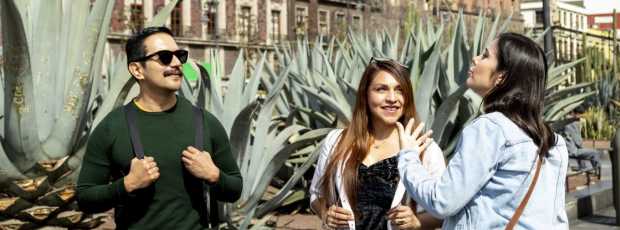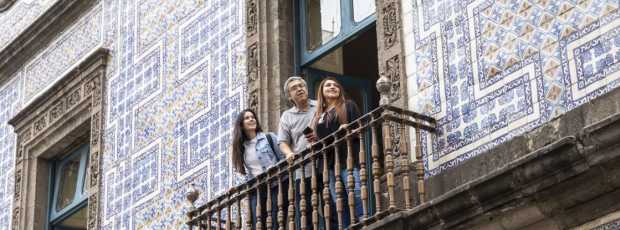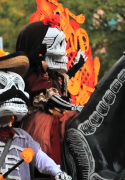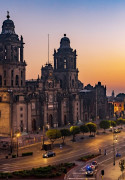Our tour with Lando was perfect, he was on time at our agreed-upon meeting spot and took the time to show us Mexico City's historical landmarks. I would highly recommend him if you're visiting the city.Brett, Mexico City, 2025
Table Of Contents
- Best Things to Do in Mexico City at Night
- Street Food After Sunset: Al Pastor and Delicious Tacos That Matter
- Rooftop Vibes and City Lights
- Mariachi and Mezcal at Plaza Garibaldi
- A Night at Lucha Libre: Colorful Masks and Loud Cheers
- Late-Night Culture: Museums, Fine Arts, and the Unexpected
- Roma Norte and Zona Rosa: Neighborhoods with a Night Pulse
- Night Markets and the Midnight Snack Scene
- A Walk Through The Historic Center
- Unexpected Calm in Chapultepec Park
- Final Thoughts: What the City Teaches You After Dark

Nighttime view of Mexico City's skyline with lights glowing
The first time someone asked me about activities in Mexico City at night, I laughed.
Where do I even start?
This ancient city doesn't sleep, and neither do its people. The streetlights flicker on, vendors roll out their carts, and suddenly the whole place comes alive with a different energy.
If you're serious about a night experience in Mexico City, continue reading my ultimate guide!

Busy Mexico City street in the evening
Best Things to Do in Mexico City at Night
Let me be clear about something right up front.
The best things to do in Mexico City when the sun's gone down revolve around food, music, and genuine human connection.
Everything else is just bonus.
I've spent years perfecting my evening routine in this city. Some nights I'm chasing the perfect al pastor taco across three different neighborhoods. Others I'm sipping mezcal on a rooftop, watching the lights twinkle below.
If you’re planning your own list of fun things to do in Mexico City, the city’s energy only gets richer as the sun goes down.

Al pastor spinning on a vertical spit with glowing coals underneath.
Street Food After Sunset: Al Pastor and Delicious Tacos That Matter
Here's where I get passionate, and probably a little obsessed. The best tacos in Mexico City come out after dark. Period. End of discussion.
During the day, you'll find decent tacos around the city. But when the sun sets, that's when the real taqueros emerge. These are the guys who've been perfecting their craft for decades.

Friends eating tacos around a table on a lit Mexico City street
The first bite of properly made al pastor at night is a religious experience. The meat is crispy on the edges, tender in the middle.
The pineapple adds sweetness that balances the chili-rubbed exterior. The tortilla, pressed fresh and still warm, holds everything together like a perfect little package.
Your Mexico City Nights, Your Way
From bustling cantinas to quiet plazas, explore CDMX after dark with a local who plans the night around you.
Rooftop Vibes and City Lights
The first time I saw Mexico City from above at night, I understood why people fall in love with this place. The lights stretch endlessly in every direction, creating patterns that look almost intentional. Like someone designed the whole city to be viewed from the sky.

Drinks at a rooftop bar against the backdrop of lights
Early hours on rooftops are magic time. Right after sunset, when the sky is still purple and the pretty lights are just starting to flicker on. I personally love finding a good observation deck (even something on the second floor can work) and seeing the spectacular views.
This is why, in my opinion, Mexico City can easily compete with the world's big cities.

Mariachi group performing in Plaza Garibaldi
Mariachi and Mezcal at Plaza Garibaldi
Plaza Garibaldi is where I take people who want to understand the soul of Mexican music. It's touristy, yes, but it's also completely genuine.
The mariachi musicians here aren't performing for tips. They're continuing a tradition that runs deeper than entertainment.
I'll warn you upfront that Garibaldi can be intense. The plaza fills with tourists, locals celebrating special occasions, and groups of friends who've had too much to drink. The energy is high, sometimes chaotic, but always real.
Locals come here for real celebrations.
The mariachi music starts around 7 PM and continues until the early morning hours. These aren't background musicians. They're artists who've studied their craft for years.
The trumpet players hit notes that make your chest vibrate. The guitarists' fingers move so fast they blur. Street performers add another layer to the plaza's atmosphere. You'll see dancers in traditional costumes, accordion players, and sometimes impromptu poetry readings. It's like the whole plaza becomes a stage for Mexican culture. Locals come here for real celebrations. Quinceañeras, anniversaries, graduations.
When something matters, people bring it to Garibaldi. I've seen grown men cry during "Las Mañanitas" sung by a full mariachi band for their mother's birthday.

Glasses of mezcal with orange slices sprinkled with sal de gusano
My advice for Garibaldi is to embrace the chaos while staying aware of your surroundings.
Keep your valuables secure, don't flash expensive electronics, and trust your instincts about which traditional and rooftop bars to enter. The plaza is generally safe, but like any nightlife area, it requires street smarts.
What if Your Night in CDMX Was Planned by Someone Who Knows It and You?
Skip the generic tours. A local host creates a flexible, private experience shaped by your style, not a set script.
A Night at Lucha Libre: Colorful Masks and Loud Cheers
Arena México is my therapy session. The combination of athletic storytelling, theatrical drama, and pure Mexican spectacle never gets old. Lucha libre isn't just professional wrestling.
It's soap opera, athletic competition, and cultural expression rolled into one sweaty, loud, glorious package.
The arena fills with families, couples on dates, groups of friends, and international travelers who have no idea what they're about to experience. The crowd becomes part of the show, cheering for técnicos (good guys) and booing rudos (bad guys) with equal enthusiasm.

Masked professional wrestling star in a crowded arena
Colorful masks are everywhere, not just on the wrestlers. Fans wear masks of their favorite luchadores, creating a sea of silver, gold, red, and blue faces in the audience. Kids clutch mini masks like precious treasures, dreaming of becoming the next great champion and taking over lucha libre shows.
The wrestling itself is impressive, but the real entertainment comes from the storytelling. Each match has heroes and villains, plot twists, and dramatic moments that would make telenovela writers jealous. The wrestlers play their characters with commitment that borders on method acting.
Lucha libre shows often include other entertainment too. Sometimes drag performers take the ring between matches, lip-syncing to popular songs while the crowd goes wild. Other nights feature live bands or traditional dancers. The arena becomes a celebration of Mexican popular culture.
The food and drink situation at Arena México is part of the experience. Vendors walk through the aisles selling beer, popcorn, and surprisingly good tortas. Eating during matches is expected, encouraged even. It's dinner theater for the working class.
What I love most about lucha libre is how it brings together different generations and social classes. Wealthy executives sit next to construction workers, all cheering for the same masked hero. In those moments, the usual divisions of Mexico City disappear. The matches usually end around 11 PM, but the energy continues outside the arena. Street vendors sell luchador merchandise, fans discuss the show's best moves, and sometimes impromptu wrestling demonstrations break out on the sidewalk.
When you have these experiences, you'll see that late-night tacos, churros, and guisados say more about what to eat in Mexico City than any high-end restaurant ever could.

Palacio de Bellas Artes illuminated with its distinctive dome
Late-Night Culture: Museums, Fine Arts, and the Unexpected
Most people don't associate museums with nighttime activities, but CDMX has several cultural venues that come alive after dark. Palacio de Bellas Artes occasionally hosts evening events that showcase a different side of the city's artistic soul.
The building itself is stunning in the evening. The Art Nouveau façade glows under carefully positioned lights, and the dome seems to float above the busy streets of Centro. Inside, the marble hallways echo with the sounds of performances, exhibitions openings, and cultural events.

People walking the steps of Bellas Artes after a performance
Fine arts events at Palacio de Bellas Artes range from classical concerts to contemporary dance performances. The acoustics in the main theater are incredible, designed to carry every note to the back row without amplification. When the lights dim and the performance begins, you forget you're in the middle of a bustling metropolis.
The museum stays open late on certain evenings, offering a quieter way to experience Mexican art and culture.
Walking through galleries of Diego Rivera murals or contemporary installations while the city buzzes outside creates an interesting contrast between contemplation and urban energy. Cultural events in this major city often spill out onto the streets around venues. After a performance at Palacio de Bellas Artes, you'll find audience members continuing conversations on the steps, discussing what they just experienced.
These impromptu discussions often lead to recommendations for other cultural activities or invitations to join groups for late-night coffee.

Paseo de la Reforma lit up in the evening
Other museums worth checking for nighttime events include Museo de Arte Moderno. You can catch evening openings with wine and live music, and Casa Azul in Coyoacán, which offers special night tours during certain seasons.
While you're at it, why not take a walk down Paseo de la Reforma? It's a lot of ground to cover, but can be fun!
Experience Mexico City Nights Your Way
Explore the city after dark with a local who knows the best spots, tailoring the night to your vibe, not a set plan.

Lights reflecting on wet pavement in Roma Norte at night
Roma Norte and Zona Rosa: Neighborhoods with a Night Pulse
When I want to dance, I head to Roma Norte. When I want diversity and energy, I choose Zona Rosa. Both neighborhoods offer completely different nighttime experiences, but both pulse with the kind of energy that makes Mexico City special.
I've found that neighborhoods like Roma hide some of the most exciting hidden gems in Mexico City, especially after dark.
Roma Norte attracts a younger, hipper crowd that values craft cocktails, independent music venues, and restaurants that experiment with traditional Mexican flavors. The tree-lined streets of Roma neighborhoods fill with twenty and thirty-somethings walking between bars, creating a natural party that flows from venue to venue.
House music and electronic music dominate many Roma Norte venues, but you'll also find live bands, jazz clubs, and rooftop bars that specialize in mezcal tastings.
The locals here knows their live music and their drinks, creating an atmosphere that feels both sophisticated and relaxed.

Crowded dance floor with colorful lights in a club
Checking Out The Best Bars in Mexico City
Some of the best bars in Roma Norte include Parker & Lenox for craft cocktails, Limantour for creative mixology, and Jules Basement for a more intimate drinking experience. Each has its own personality, but all share a commitment to quality and creativity that sets them apart from generic nightlife.
The dance floor culture in Roma Norte is different from other parts of the city. People actually dance instead of just standing around taking photos. The music is mixed by DJs who understand how to read a crowd and build energy throughout the night.
Zona Rosa offers a more diverse nighttime experience. The neighborhood has been Mexico City's LGBTQ+ center for decades, creating a welcoming atmosphere for everyone regardless of sexual orientation or gender identity.
The energy here is celebratory, accepting, and often outrageous in the best possible way.
The bars and clubs in Zona Rosa range from intimate cocktail lounges to massive dance venues that stay open until sunrise.
Drag shows happen regularly, featuring performers who've elevated the art form to theatrical levels that rival any Broadway production. What I appreciate most about both neighborhoods is how they represent different aspects of modern Mexico City.
Roma Norte shows the city's creative, cosmopolitan side. Zona Rosa celebrates diversity, acceptance, and the joy of being exactly who you are.
Overall, Roma Norte, Condesa, and Centro Histórico rank among the best neighborhoods in Mexico City for exploring after dark.
More than 26,240 5-star reviews and counting
26,240+ 5-Star Reviews and Counting
Trusted and recommended by travelers worldwide.

Creepy-looking stall in Mercado de Sonora
Night Markets and the Midnight Snack Scene
Mercado de Sonora is not your typical market. Open late into the night, it specializes in herbs, traditional medicine, and items used in spiritual practices. It's also known as the witch market, which makes it a must-see for visitors and a unique nighttime stroll.

Colorful market stalls with hanging lights and late-night food vendors
You may be surprised, but has some of the best late-night food stalls in the city, serving hungry night owls who need sustenance for their adventures.
The market's unique ambiance comes from its mix of commerce and culture. You'll find vendors selling everything from love potions to lottery tickets, creating an atmosphere that feels both mystical and completely practical. The food stalls benefit from this foot traffic, staying busy while other markets close for the night.
Street food at night markets differs from daytime offerings in both variety and intensity. The salsas are spicier, the portions are larger, and the combinations get more creative. Vendors experiment with fusion flavors that would never work during conventional meal times.

Tourists having a fun night enjoying Mexican cuisine
Other night markets with amazing Mexican cuisine worth exploring include Mercado de Medellín, which stays open late on weekends and offers excellent tacos de canasta, and the informal markets that pop up around Arena México after lucha libre events.
The social aspect of night market eating is just as important as the food itself.
Shared tables force conversations between strangers, vendors become temporary friends, and the boundaries between tourist and local blur over shared appreciation for good food.

Cathedral and Zócalo illuminated at night with few people
A Walk Through The Historic Center
The historic center of Mexico City changes after dark into something almost magical. The colonial grand architecture, usually overwhelmed by daytime crowds and traffic, becomes the star of the show when illuminated by carefully placed spotlights.
If you're a history buff, this place is your best bet for a fun Friday night (or whenever you visit). Guided tours may not be possible at night, but you can explore at night with locals and experience education and good vibes.
Centro Histórico at night is where you feel the weight of history most strongly. Walking past buildings that are hundreds of years old, on streets that follow the same patterns as ancient Aztec canals, connects you to the continuous story of this place.

Music and dancing in the streets
Plaza de la Constitución, better known as the Zócalo, becomes particularly impressive after sunset. The massive square, one of the largest in the world, feels both intimate and monumental when lit by the surrounding buildings.
The nighttime stroll through Centro reveals details invisible during busy daylight hours. Architectural features seem to emerge from shadows, carved stone figures imitate movement in flickering light, and the patina on bronze statues tells stories of centuries of weather and human touch.

The UNESCO World Heritage site, the Historic Center
Performers in Centro Histórico at night range from solo guitarists to full mariachi bands to break dancers who use the smooth stones of the plaza as their stage.
The acoustics of the colonial buildings amplify their performances, creating natural amphitheaters throughout the area.
The UNESCO World Heritage site designation becomes more meaningful at night when you can appreciate the preservation efforts without daytime distractions.
Now, you may wonder: is Mexico City safe at night? Sure! As long as you don't go looking for trouble or venture into shady areas, you'll be perfectly fine. Invest in travel insurance if you're really wary.
Unexpected Calm in Chapultepec Park
Chapultepec Park at night offers a completely different experience from the daytime crowds of families and tourists. The well-lit pathways and regular security patrols make it ideal for evening walks.

Chapultepec Light cycles: Crystal Grove
The park's lake reflects the surrounding lights, creating mirror images that double the beauty of the landscaping. Couples often walk the paths around the water, making it one of the more romantic nighttime activities in the city.
What surprises most visitors is how quiet the park becomes after dark. The usual sounds of children playing and vendors calling out fade away, replaced by the rustle of leaves and distant city traffic. It's a peaceful contrast to the energy of Mexico City's street life.
The monuments and sculptures throughout Chapultepec take on different personalities in the evening.
Lighting designers have carefully positioned spots to highlight the artistic details while creating dramatic shadows that add depth and mystery to familiar landmarks.
Night walking in Chapultepec often leads to unexpected encounters with other park users: joggers training for marathons, photographers capturing long-exposure shots, and groups practicing tai chi or other martial arts.
The park becomes a community space for people seeking alternatives to rooftop bar and restaurant nightlife.
The view from Chapultepec Castle in the evening when it's open for special events, provides another perspective on the city's lights. From this elevated position, you can see how the park creates a dark green space in the middle of the urban glow, like a breathing space for the city.

Ending the day with a hot chocolate at Tout Chocolate
Final Thoughts: What the City Teaches You After Dark
After all these years of late wandering through my city, I've learned that the city at night shows truths that daylight hides. People are more relaxed, more willing to share stories, more open to connections with strangers. The pace slows down just enough to allow for meaningful interactions. If your nights are full but your days are free, consider mixing in a few unforgettable day trips from Mexico City to round out your visit.
Whether you're eating tacos on a street corner, trying wine tasting tours, making a stop at Parque Mexico, or dancing on a rooftop, you're joining a tradition that goes back generations.
If you're planning to explore more of what this incredible city offers, check out other Mexico experiences that will help you understand why locals like me never get tired of discovering new corners of our hometown.
And if you're visiting during October or November, don't miss the things to do in Mexico City for Day of the Dead, when the entire city becomes a celebration of life, death, and everything in between. Those nights have their own special magic that connects you to the deepest traditions of Mexican culture.
The city will teach you something new every night if you're paying attention. All you have to do is step outside and follow your curiosity. The tacos, the live music, and the stories are waiting for you.
More Mexico City For You
Mexico City Nights, Your Way
SEE EXPERIENCESYour Night in Mexico City, Planned Around You
City Unscripted pairs you with a local who shapes the evening around what you love, not a rigid plan.
Wish you had a local friend in Mexico City?
One who knows the city inside out and could plan a private day just for you? Our local hosts do exactly that: no scripts, no tourist traps, just the side of the city most people miss.









